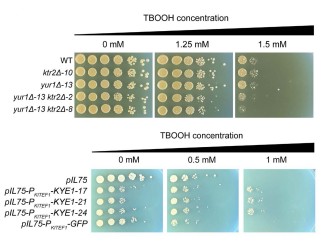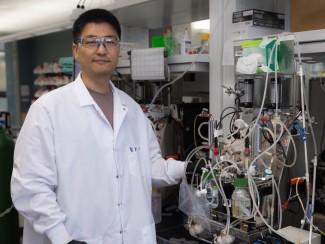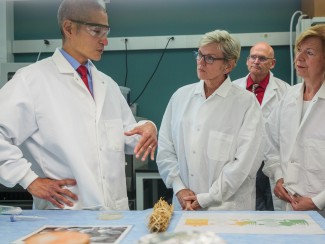
As the Keegstra Fellow exploring microbial synthetic biology, Kyle Kinney is working with Jason Peters and Tim Donohue at the University of Wisconsin–Madison to develop genetic and synthetic biology tools for several bioenergy-relevant bacteria, such as Zymomonas, Rhodobacter, and Novosphingobium. Kyle started his position in July. Connect with him at kkinney4@wisc.edu.
You’re just getting started at GLBRC. How has it been starting a new fellowship in the middle of a pandemic?
I really haven't had time to fully adjust to everything. For the first week and a half, I couldn't even go to lab—now that there’s some reopening I've actually gotten in the lab, which has been nice. I hadn't been in lab for six or seven months since I was just writing my thesis before I graduated. So it was a big day the first time back—even though it was with a face mask and social distancing, it was still fun.
Tell us a little about your background. What and where did you study before joining GLBRC?
I got my undergrad degree in biology and chemistry at Morningside College, in Sioux City, Iowa. It's a very small liberal arts school. It’s in my hometown and my mom worked there, so I got a good deal. From there, I went to grad school for my Ph.D. at the University of Iowa and joined the lab of Wilmara Salgado Pabón. We studied Staphylococcus aureus pathogenesis in infective endocarditis, which is a heart infection—a far cry from what I'm doing now!
What brought you to bioenergy research? Why do you think it is important?
While I was at Iowa, I got a research training grant in biotechnology and did an internship at a biotech company, Integrated DNA Technologies, or IDT. Many people in the GLBRC may order primers from IDT. I got to work with CRISPR gene editing at this company, which got me intrigued in Jason's Mobile-CRISPRi system and this crossover with bioenergy.
I want to study something that's relevant and that can help a lot of people. Obviously infectious disease can do that. But a lot of people that aren't in the field don't even consider renewable energy, especially with microbes, and how important it could be to our future. That's why I wanted to do this, because I think it's such an important thing to do for society in the next few years.
What led you to this Keegstra fellowship?
During my final year of my graduate degree, my graduate advisor moved to the University of Wisconsin–Madison, and she forwarded me an email about the Keegstra fellowship. The timeline fit really well and she encouraged me to apply. And I had actually met Jason when he interviewed at Iowa. I was maybe a first- or second-year grad student and I remember thinking that his work was very cool. I never imagined that three years later, I'd be interviewing with him.

MORE ON MOBILE-CRISPRi
Gene-editing tool now being used to develop better antibiotics
In a paper published in Nature Microbiology in January 2019, Jason Peters and his collaborators reported a new technique for studying the function of genes in bacteria called Mobile–CRISPRi.
Which research groups are you working in, and what will you be working on?
Jason Peters is my primary mentor. I’ll be designing and testing Mobile-CRISPRi tools for Rhodobacter and Novosphingobium. CRISPRi allows you to study full gene systems at once, and it also allows you to study essential genes because you’re not cutting out a gene completely, you're just not allowing it to express at a very high level. We can kind of titrate the response to see what other genes are affected and what's happening to the cellular metabolism of the organism when we do that. That will help us figure out major players that we may want to target to affect, for example, the ability to survive different environmental stressors or the yield of bioproducts.
These types of systems have not been done much in these organisms, so the first challenge is to make a tool and get it into the organism, then the second part is seeing if it actually works. From there, we’ll decide what gene systems we want to look at, and the experimentation and testing will be done in Tim Donohue's lab.
This program is about bridging different areas of research within the GLBRC. How will you be doing that? Have you done interdisciplinary work before?
Thinking across the different aims, microbes play an important part in bridging the whole process from crops all the way to bioproducts. So I imagine that multiple different labs might be interested in what these tools can do.
In grad school for my pathogenesis studies, I did a lot of in vivo work with rabbits and I worked with a team of veterinary specialists, veterinary pathologists, NMR specialists, metabolomic specialists. They all specialized in different areas, so communication was really key for explaining the experiment and what we were trying to accomplish. GLBRC is even more interdisciplinary, so I think that will be exciting, but also a little bit of a challenge too.
What do you hope to move on to after this position?
I have a few different ideas. I like tool building and I like solving puzzles, so I might want to go into biotech or the pharmaceutical industry. I've also thought about clinical microbiology, which again has to do with designing and standardizing tests in a clinical setting.
What do you like to do outside the lab?
Pretty much anything outdoors. Running, biking, being on the water, like paddleboarding or kayaking. I'm pretty active, I try to be outside as much as possible. And I take care of my pug, Bella. My girlfriend has a little miniature Australian shepherd, Ruby. We didn't plan this, but because they're Ruby and Bella, together we call them Rubella—some microbiologists laugh at that.
The Keegstra Bioenergy Research Fellowships are two-year postdoctoral appointments in integrative bioenergy sciences that promote interdisciplinary research in lignocellulosic bioenergy and bioproducts. Learn more





